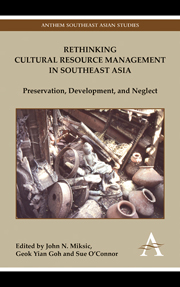Book contents
- Frontmatter
- Contents
- List of Tables and Figures
- Introduction: John N. Miksic
- Southeast Asia (General)
- East Timor
- Chapter 3 Whose Culture and Heritage for Whom? The Limits of National Public Good Protected Area Models in Timor Leste
- Chapter 4 Archaeological Practice in Timor Leste: Past, Present and Future
- Cambodia
- Myanmar
- The Philippines
- Singapore
- Vietnam
Chapter 3 - Whose Culture and Heritage for Whom? The Limits of National Public Good Protected Area Models in Timor Leste
from East Timor
Published online by Cambridge University Press: 05 May 2012
- Frontmatter
- Contents
- List of Tables and Figures
- Introduction: John N. Miksic
- Southeast Asia (General)
- East Timor
- Chapter 3 Whose Culture and Heritage for Whom? The Limits of National Public Good Protected Area Models in Timor Leste
- Chapter 4 Archaeological Practice in Timor Leste: Past, Present and Future
- Cambodia
- Myanmar
- The Philippines
- Singapore
- Vietnam
Summary
Introduction
The issue of cultural sovereignty continues to be a prominent one in Timor Leste, which is now liberated from Indonesian rule. Out of the ashes of recent history, various ethnic groups are increasingly demanding their own cultural space and authority within the fledgling nation-state, as the conflicts following independence amply demonstrated. It is within this context that we wish to discuss the declaration of Nino Konis Santana National Park, the first national park in Timor Leste. This paper will examine fundamental issues with the concepts of “national heritage,” public good, protected area models and the assignment of cultural and natural heritage values to the park.
At the time the Nino Konis Santana National Park was first proposed, reports emphasized the natural values of the park to the neglect of cultural values (see Trainor et al. 2003; Whistler 2001). Since the 1970s, this has become a common ideal worldwide where nature is viewed as a biodiversity bank which must be preserved at all costs (Katz 1998; Luke 2003; Pannell 2006b, 13). However, the Nino Konis Santana National Park contains six villages and is home to over fifteen thousand people. In every regard it constitutes an area where over time, the interaction of people and nature has produced a landscape with significant cultural value. Research shows that this area contains “manifestations of unique [and] traditional land use patterns and social organizations as evidenced in human settlements, local customs, livelihoods, and beliefs” (IUCN 1994, 22).
- Type
- Chapter
- Information
- Rethinking Cultural Resource Management in Southeast AsiaPreservation, Development, and Neglect, pp. 39 - 66Publisher: Anthem PressPrint publication year: 2011
- 2
- Cited by



